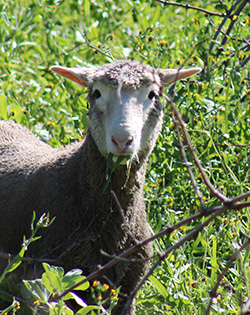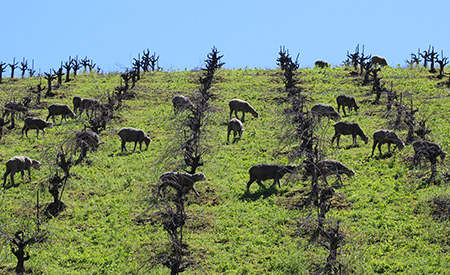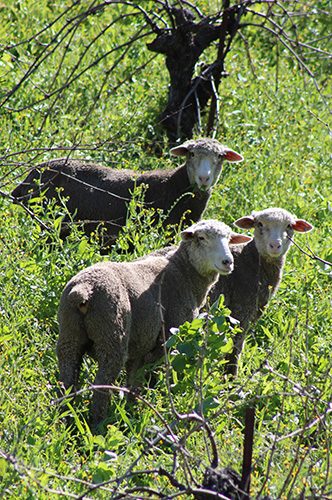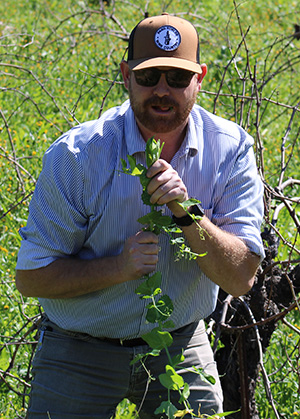Fluff Piece: Keeping Our Ranch in Sheep

SHEEEEEEEEEEEEEEEEEP
Sheep, it’s all we can talk about around here. Before now, I didn’t get what made them worth the trouble. But I now know what all the hype is about - their moves are synchronized, they wear the same outfit, and appear to swim in a sea of green grass. It’s like watching a barnyard Doo Wop group mow your lawn!
As viticulturalists and shepherds gain knowledge and experience, we’re starting to see wider adoption of grazing sheep in vineyards across our AVA. This is very significant, as farmers are typically cautious, and therefore slow to make changes in their operations that sacrifice any amount of control. We’re already at the whim of mother nature, and sheep aren’t animals we can control entirely. In fact, many of those that have taken on this challenge will share stories of how sheep or goats have eaten canes off vines, devastated crops, or compacted their soil. These kinds of detrimental outcomes are what can keep us up at night.
But many of us have also learned from the problems of the past and are more comfortable than ever opening our gates to the contributions of these four-legged and fluffy lawnmowers. In fact, we chose to do this for several benefits.
Why Sheep?
 Their mitigation capabilities allow us to get into vineyards early in the season without having to start a tractor and mow down a cover crop, all while adding nutritious fertilizer to our vineyards. Especially in a wet year like this, the sheep manage the cover crop while it’s still too wet to get a tractor in the field. We get a mow, and the shepherd gets nutrient rich feed for the herd, all the while supporting the growth of our crops.
Their mitigation capabilities allow us to get into vineyards early in the season without having to start a tractor and mow down a cover crop, all while adding nutritious fertilizer to our vineyards. Especially in a wet year like this, the sheep manage the cover crop while it’s still too wet to get a tractor in the field. We get a mow, and the shepherd gets nutrient rich feed for the herd, all the while supporting the growth of our crops.
Wooly Workers Welcomed
Adelaida’s vineyards have now been certified organic for five years and without any herbicides for over a decade. We use hand tools and tractor implements to terminate vegetative growth on the vineyard floor. Adding animals to the equation really makes sense in an environment where we have become more conscious of our footprint on the world by giving us another tool to manage the vineyards in an ecologically responsible way. We also look for any opportunity to add biodiversity to a monoculture like a vineyard, and sheep provide microbiomes that encourage the development of healthier soils and vines.

Our Partner Makes it Possible
 The willingness of the sheep industry to think outside the box and offer this service is huge. Adelaida has dabbled in this in the past, but we are now adopting this across far more of our vineyard land than in years past, as this practice has proven very helpful. We’re shooting for a 2-week window before budbreak, to allow the sheep to make a single pass. This requires 2,000-3,000 sheep and a dedicated shepherd who lives on site with multiple guardian & herding dogs to protect and manage the flocks (Fin and Oliver will not be enlisted for duty – despite their eager willingness to serve).
The willingness of the sheep industry to think outside the box and offer this service is huge. Adelaida has dabbled in this in the past, but we are now adopting this across far more of our vineyard land than in years past, as this practice has proven very helpful. We’re shooting for a 2-week window before budbreak, to allow the sheep to make a single pass. This requires 2,000-3,000 sheep and a dedicated shepherd who lives on site with multiple guardian & herding dogs to protect and manage the flocks (Fin and Oliver will not be enlisted for duty – despite their eager willingness to serve).
We’re still newbies to the shepherd life, and I expect we will have some bumps along the way. But, with the hard work and guidance of Cole Bakke (a third generation Shepherd, and the owner of IOU Sheep Co.) we are in great shape. He is clearly motivated and looking for creative ways to keep his industry thriving, and we’re proud to be a part of that effort. Adelaida’s goal is always to make wines of place and get there by farming with a conscience, so I’m always grateful to work with people who value the process as much as the product.
 About the Author
About the Author
- Chad Taber is Adelaida's Ranch Manager.
- His responsibilities are to manage the ranch.
- He prefers eating snap peas off the vine - they're fresher that way.
